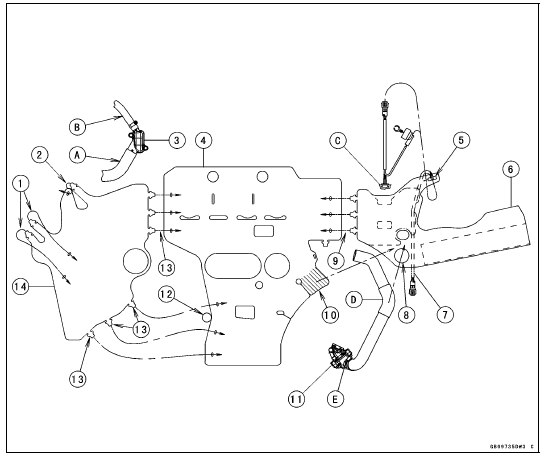


1. Hold the water hose [A]. Insert the tab into the slot.
2. Hold the water hose [B]. Insert the tab into the slot.
3. Water Hose Fitting on Cylinder Head
4. Heat Insulation Rubber Plate
5. Run the crankshaft sensor lead and the oil pressure switch lead into the slot, and hook the slot on the grommet of the crankshaft sensor [C].
6. Right Heat Insulation Rubber Plate
7. Run the crankshaft sensor lead to inside of the rubber plate.
8. Run the water hose [D], and hook the water hose clamp screw [E].
9. Insert the tabs into the slots.
10. Place this portion to inside of the right heat insulation rubber plate.
11. Thermostat
12. Run the gear position switch lead here.
13. Insert the tabs into the slots.
14. Left Heat Insulation Rubber Plate
 Engine No. ZXT00JE003023
Engine No. ZXT00JE003023 Troubleshooting Guide
Troubleshooting GuideFuel Consumption
This display mode shows the fuel
consumption in Liter or Gallon by numerical
value counted from the start of
measuring to present time.
A. Fuel Consumption
B. “L”
While the fuel consumption is displayed,
push the lower button and
hold it in until the fuel consumption
values re ...
Moving Off
Check that the side stand is up.
Pull in the clutch lever.
Shift into 1st gear.
Open the throttle a little, and start to
let out the clutch lever very slowly.
As the clutch starts to engage, open
the throttle a littlemore, giving the engine
just enough fuel to keep it from
stallin ...
Fuel Hose Replacement
Remove the fuel tank (see Fuel Tank Removal in the Fuel
System (DFI) chapter).
WARNINGFuel is flammable and explosive under
certain conditions
and can cause severe burns. Be prepared
for fuel spillage; any spilled fuel must be completely
wiped up immediately. When the fue ...